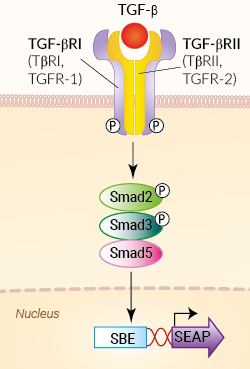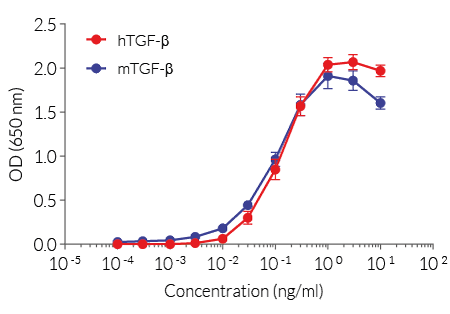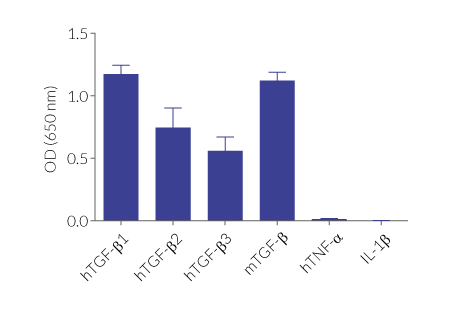TGF-β Reporter HEK 293 Cells
| Product | Unit size | Cat. code | Docs. | Qty. | Price | |
|---|---|---|---|---|---|---|
|
HEK-Blue™ TGF-β Cells Human & Mouse TGFβ SEAP Reporter Cells |
Show product |
3-7 x 10e6 cells |
hkb-tgfbv2
|
|||
|
HEK-Blue™ TGF-β vial Additional cell vial |
Show product |
3-7 x 10e6 cells |
hkb-tgfbv2-av
|
![]() Cytokine offer: For each cytokine reporter cell line purchased, get a free vial of the matching cytokine.
Cytokine offer: For each cytokine reporter cell line purchased, get a free vial of the matching cytokine.
TGF-β responsive Smad-SEAP reporter assay

Signaling pathway in HEK-Blue™ TGF-β cells
InvivoGen also offers:
HEK-Blue™ TGF-β cells are designed to monitor human TGF-β-induced Smad stimulation or inhibition. This colorimetric bioassay can be used to screen activatory or inhibitory molecules, such as engineered cytokines and neutralizing antibodies, respectively.
HEK-Blue™ TGF-β cells respond specifically to recombinant human TGF-β. Their reliable and consistent performance makes them suitable for release assays of activatory and inhibitory molecules, such as Fresolimumab, a monoclonal antibody targeting all isoforms of TGF-β (see figures).
Note: This cell line has been replaced by another clone with an improved reporter/background signal ratio. The cat code has been changed accordingly (hkb-tgfbv2).
Key features
- Readily assessable Smad-SEAP reporter activity
- Convenient readout using QUANTI-Blue™ Solution
- High sensitivity to human (h)TGF-β1 and mouse (m)TGF-β1 activity
- Stability guaranteed for 20 passages
Applications
- Therapeutic development
- Drug screening
- Release assay
Transforming growth factor-beta (TGF-β), also known as tumor growth factor-beta, is a secreted cytokine that regulates numerous cellular functions, such as cell proliferation, apoptosis, differentiation, and migration.
All InvivoGen products are for internal research use only, and not for human or veterinary use.
Back to the topSpecifications
Cell type: Epithelial
Tissue origin: Human Embryonic Kidney
Target: TGF-β
Specificity: Human, mouse
Reporter gene: SEAP
Antibiotic resistance: Zeocin®
Detection range: 30 pg/ml - 10 ng/ml (hTGF-β and mTGF-β)
Growth medium: Complete DMEM (see TDS)
Growth properties: Adherent
Mycoplasma-free: Verified using Plasmotest™
Quality control: Each lot is functionally tested and validated.
Back to the topContents
HEK-Blue™ TGF-β Cells (hkb-tgfbv2)
- 1 vial containing 3-7 x 106 cells
- 1 ml of Zeocin® (100 mg/ml)
- 1 ml of Normocin® (50 mg/ml)
-
1 ml of QB reagent and 1 ml of QB buffer (sufficient to prepare 100 ml of QUANTI-Blue™ Solution, a SEAP detection reagent)
HEK-Blue™ TGF-β vial (hkb-tgfbv2-av)
- 1 vial containing 3-7 x 106 cells
![]() Shipped on dry ice (Europe, USA, Canada, and some areas in Asia)
Shipped on dry ice (Europe, USA, Canada, and some areas in Asia)
Notification: Reference #hkb-tgfbv2-av can only be ordered together with reference #hkb-tgfbv2.
Back to the topDetails
Cell line description
HEK-Blue™ TGF-β cells were generated by stable transfection of the human embryonic kidney HEK293 cell line with a Smad-inducible secreted embryonic alkaline phosphatase (SEAP) reporter. The binding of TGF-β to its receptor triggers a signaling cascade leading to the formation of a Smad2/Smad3/Smad4 complex. The heterocomplex enters the nucleus and binds SBE (Smad binding elements) sites in the engineered minimal promoter, thereby inducing the production of SEAP. This can be readily assessed in the supernatant using QUANTI-Blue™ Solution, a SEAP detection reagent.
HEK-Blue™ TGF-β cells detect human (h) and mouse (m) TGF-β. Of note, they detect all three isoforms of hTGF-β: hTGF-β1, hTGF-β2, and hTGF-β3 (see figures).
TGF-β background
Tumor growth factor-beta (TGF-β) belongs to a family of structurally related cytokines that regulate a plethora of cellular functions, such as proliferation, apoptosis, differentiation, and migration [1,2]. TGF-β exists in at least three isoforms; TGF-β1, TGF-β2, and TGF-β3. In the immune system, TGF-β1 is the predominant isoform [1]. It is produced by many cell types, including macrophages, in a latent form that is bound to two other polypeptides, latent TGF-β1 binding protein (LTBP) and latency-associated peptide (LAP). Upon cleavage of these proproteins, the mature TGF-β1 is released. This mature protein can bind its cell surface receptors and initiate signaling.
TGF-β binds to type II receptors (TβR-II) which recruit and activate type I receptors (TβR-I). The active ligand-heterotetrameric receptor complex signals through downstream transcriptional factors named Smads, including Smad2, Smad3, and Smad4.
Smad complexes translocate into the nucleus where they regulate the transcription of target genes, which contain one or more Smad binding elements (SBEs) in their promoter region [3]. Perturbations in TGF-β signaling affect immune homeostasis and tolerance, leading to inflammatory diseases and tumor immune evasion [3].
1. Travis MA. & Sheppard D., 2014. TGF-β activation and function in immunity. Annu Rev Immunol. 32:51-82.
2. Taylor AW., 2009. Review of the activation of TGF-beta in immunity. J Leukoc Biol. 85(1):29-33.
3. Battle E. & Massagué J., 2019. Transforming Growth Factor-beta Signaling in Immunity and Cancer. Immunity. 50(4):924.










